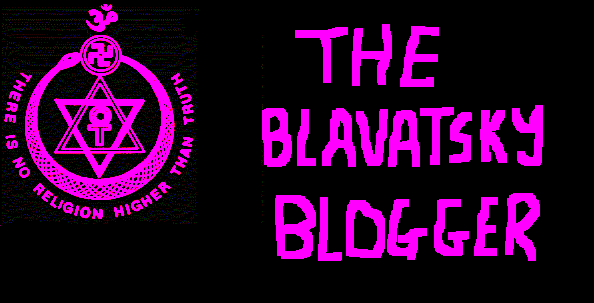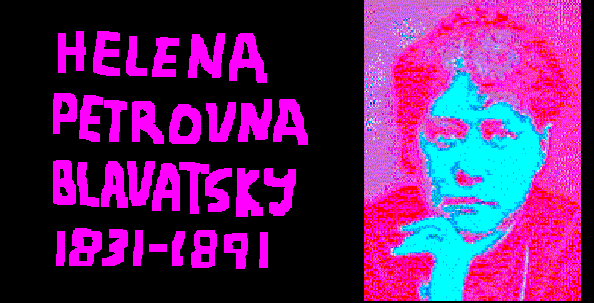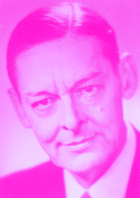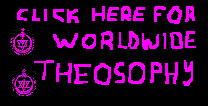Blavatsky Blogger

Taking Theosophical
ideas
into the 21st
century

T
S Eliot’s Hollow Men
Do
we meet H P Blavatsky’s Soulless Beings?
"Shape
without form and shade without color
Paralysed force, gesture without motion;”
Posted15/12/06

H P Blavatsky makes several references to Soulless Beings or
Soulless Men and Women
From Isis Unvelied
Volume II
“We elbow soulless men and women at every step in life.”
From the Secret Doctrine, Volume I
“Many are the Soulless men among us, for the occurrence
is found to take place in wicked materialists as well as in persons who advance
in holiness and never turn back."
Here are some examples from H P
Blavatsky’s Theosophical Glossary
Avitchi (Sk.) A state: not necessarily
after death only or between two births, for it can take place on earth as well. Lit., “uninterrupted hell”.
The last of
the eight hells, we are told, “where the culprits
die and are reborn without interruption—yet not without hope of final
redemption. This is because Avitchi is another name
for Myalba (our earth) and also a state to which some
soulless men are condemned on this physical plane.
And under the entry for Incubus
Vampires and
soulless Elementals; formless centres of Life, devoid of sense; in short,
subjective protoplasms when left alone, but called
into a definite being and form by the creative anddiseased
imagination of certain mortals.
And here an indication is given of the lack of
spiritual progess made by a Soulless Man as he moves
through the cycle of death and rebirth
Pâpa-purusha (
the state of Avitchi—hence,
“Soulless”.
Soulless Beings (A
definition)
Men and women who are still connected, but usually quite
unconsciously, with the monad, the spiritual essence within them, but not self-consciously
so; they live very largely in the brain-mind and in the fields of sensuous
consciousness. "We elbow soulless men in the streets at every turn,"
wrote Blavatsky. This does not mean that those people have no soul, but that
the spiritual part of these human beings is unable to manifest itself through
the unawakened brain-mind and feelings. They are
animate humans with an animate working brain-mind, but otherwise soulless in
the sense that the soul is insufficiently expressive. This is what Pythagoras
meant when he spoke of the living dead, or the spiritually useless portion of
mankind. They live in the ordinary mind and in the body, thinking only of and
in these small and restricted spheres of consciousness. Such
"soulless" people are very numerous. Soulless beings are not to be
confused with lost souls.
_____________________
A Brief
Biography of T S Eliot
The Hollow
Men and Soulless Beings
The Hollow
Men was published in 1925 and
evokes the depression
and sense of hopelessness in the aftermath of the First World War. The poem uses
the bleak imagery of Dante's Inferno.
The poem
depicts figures, "gathered on the beach of the tumid river" - drawing
considerable influence from Dante's third and fourth cantos of the Inferno which
describes limbo, the first circle of hell - unable to communicate or express
themselves.
The story is
told from five perspectives, each representing a phase of the passing of a soul
into
"death's dream kingdom", Eliot describes how we, the living will be
seen by "those who have crossed with direct eyes... not as lost violent
souls, but only as the hollow men -- the stuffed men."
Eliot like
H P Blavatsky sees Soulless Beings everywhere but goes a bit father by postulating
that they constitute the majority and our destiny is in their hands.
These higher
selves are do not function and they are incapable of
feeling anything, they have failed to make an imprint, either good or bad on
life. Their higher faculties only exist in potential and they have nothing to
take with them into the after death state and no life learning to distill. Eliot
describes them as hollow or stuffed with heads filled with straw.
“Shape
without form, shade without colour,
Paralysed force, gesture without motion;”
These two
lines which stand as a verse on their own refer to the ability of a Hollow
Man/Soulless Being to apparently function normally in
the physical world.
“Remember
us -- if at all -- not as lost
Violent
souls, but only
As the
hollow men”
This is a
reference to the carnage of the First World War which for which everyone must
accept some blame.
“For Thine is
Life is
For Thine is the”
Although
Eliot was converting to High Anglicanism at this time, he included these
incomplete lines from the Lord’s Prayer as a reference to the failure of established
Christianity to prevent the First World War
“Here we
go round the prickly pear”
This
unusual image may be a reference to the way in which man engages in
confrontation using modern weaponry. Eliot may have seen that another major war
was only fourteen years away.
“This is
the way the world ends
Not with a
bang but a whimper.”
Eliot
seems to see mankind as sleepwalking into its own oblivion led by Hollow Men.
Here is
the poem in full;
The Hollow Men
by
T.S. Eliot
Published
I
We are the
hollow men
We are the
stuffed men
Leaning
together
Headpiece
filled with straw. Alas!
Our dried
voices, when
We whisper
together
Are quiet
and meaningless
As wind in
dry grass
Or rats'
feet over broken glass
In our dry
cellar
Shape
without form, shade without colour,
Paralysed force, gesture without motion;
Those who
have crossed
With direct
eyes, to death's other Kingdom
Remember
us -- if at all -- not as lost
Violent
souls, but only
As the
hollow men
The
stuffed men.
II
Eyes I
dare not meet in dreams
In death's
dream kingdom
These do
not appear:
There, the
eyes are
Sunlight
on a broken column
There, is
a tree swinging
And voices
are
In the
wind's singing
More
distant and more solemn
Than a
fading star.
Let me be
no nearer
In death's
dream kingdom
Let me
also wear
Such
deliberate disguises
Rat's
coat, crowskin, crossed staves
In a field
Behaving
as the wind behaves
No nearer
--
Not that
final meeting
In the
twilight kingdom
III
This is
the dead land
This is
cactus land
Here the
stone images
Are
raised, here they receive
The
supplication of a dead man's hand
Under the twinkle
of a fading star.
Is it like
this
In death's
other kingdom
Waking
alone
At the
hour when we are
Trembling
with tenderness
Lips that
would kiss
Form
prayers to broken stone.
IV
The eyes
are not here
There are
no eyes here
In this
valley of dying stars
In this
hollow valley
This
broken jaw of our lost kingdoms
In this
last of meeting places
We grope
together
And avoid
speech
Gathered
on this beach of the tumid river
Sightless,
unless
The eyes
reappear
As the
perpetual star
Multifoliate rose
Of death's
twilight kingdom
The hope
only
Of empty
men.
V
Here we go
round the prickly pear
Prickly
pear prickly pear
Here we go
round the prickly pear
At five
o'clock in the morning.
Between
the idea
And the
reality
Between
the motion
And the
act
Falls the
Shadow
For Thine is the Kingdom
Between
the conception
And the
creation
Between
the emotion
And the
response
Falls the
Shadow
Life is
very long
Between
the desire
And the
spasm
Between
the potency
And the
existence
Between
the essence
And the descent
Falls the
Shadow
For Thine is the Kingdom
For Thine is
Life is
For Thine is the
This is
the way the world ends
This is
the way the world ends
This is
the way the world ends
Not with a
bang but a whimper.
______________________
The Blavatsky
Blogger
Taking Theosophical
ideas
into the 21st
century
__________________________
Postings
to this Website reflect
the
views of The Blavatsky Blogger.
Please
don’t go looking for anyone else.

